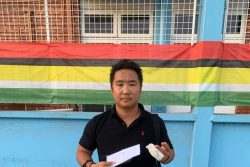One of our stories in this week’s edition of the Stabroek Business concerns the unfolding progress of the already considerably successful Jamaica Producers’ Group, (JPG) which, based on the contents of its performance profile, would appear to be among the ‘high fliers’ in the country’s agricultural sector and agro-processing sectors.
Much of JPG’s productive capacity is reflected in its exploits in the agro-processing sector, not just at home in Jamaica, but elsewhere in the Caribbean where it appears to be doing well in the production and marketing of plantain chips and other agro-based products.
Our current JPG story is focussed, primarily, on the company’s announcement that it is about to sink $J100 million into the creation of a plantain farm to go along with its already existing banana and pineapple cultivation pursuits. Here, JPG has in mind not just the further expansion of its existing successful plantain chips enterprise but also the diversification into other plantain-based products as well as the marketing of the plantains themselves.
Such a move, we believe, would only be made by a company that reposes considerable confidence in its business model based on the returns that that model has realised so far and specifically in what must be its particular ability not just to produce high-quality agro products, but also to successfully market what it produces. One need hardly add, of course, that within CARICOM, Jamaica stands out for the considerable success that it has garnered in the marketing of its goods and services both inside and outside the region.
Here, the point should be made that the Jamaica Promotions Corporation (JAMPRO), the country’s state-run national investment and export agency and almost certainly the most successful institution of its kind in the region – “the gateway which connects Jamaica to the world,” according to one of the many salutary descriptions of the entity – has, from all accounts, spared no effort in promoting the Jamaica brand across the world.
Based entirely on the respective sizes of the agriculture sectors in the two countries, it has to be said that one is hard-pressed to find a really good reason why Guyana is not, at the very least, seriously rivaling Jamaica in terms of its productive prowess in the area of agro-processing and equally importantly in the area of effectively drawing the attention of the wider global market to what we have to offer.
If, officially, we continue to pay lip service to our non-existent condition of national food security, the growth of the country’s agro-processing sector, particularly, continues to be stymied, first, by an absence of really robust official support for the expansion of the sector. Whatever may be said to the contrary, government, over time, has not been even nearly as aggressive as it might have been in providing material support for the agro- processing sector or in ‘talking up’ the sector to our largely indifferent lending agencies.
What the recent JPG J$100 million investment also proves is that if a country’s agro-processing sector is to succeed, that success must be rooted in a commensurate investment in raw materials. This is the reason for the company’s huge investment in its new plantain farm.
One, of course, need hardly make a comparison between Guyana and Jamaica where international product promotion is concerned. While our sister CARICOM country has been, over the years, pushing its brand vigorously across the globe, we have contented ourselves, largely, with making mostly domestic noises about our agricultural and agro-processing potential, seemingly not cognizant that there are no tangible rewards to be had for simply mouthing off about potential. Here, the point should be made that over time, such efforts as have been made to promote our product and country profiles have been, to a large extent, blighted by a worrying external perception that we are, socio-politically, a dysfunctional nation.
Over time, attempts at international product promotion, for which credit for most of the relatively recent effort should go to the Guyana Marketing Corporation (it would be more than a little helpful if we can be furnished with a more generous measure of public enlightenment as to just what the work programme of the GMC is, going forward) it has to be said that as things stand and for all the noises about marketing Guyana abroad, there has not existed, for as long as one can remember, a clear and coherent agenda for product and country promotion insofar as Guyana is concerned. Such issues have, more or less, languished in the realm of political gaff. Perhaps the change that is needed is awaiting on the impetus that we appear to anticipate from our share of the returns from the oil and gas industry.
To return to the matter of the JPG’s $J100 million investment in a plantain farm it will be recalled that local agencies like Sterling Products and the Guyana Manufacturing & Services Association (GMSA) appeared to have been using the UncappeD forum to help promote the accelerated use of plantains in the agro-processing sector. There had occurred, at the time, some measure of muted discussion on the subject of popularising plantain fries to the level that we had previously popularised potato fries. Not a great deal, mind you, had been said about its export potential. Whether or not the idea ever secured any traction with the authorities is unclear.
The bottom line here is that when one takes into account the huge difference between the agricultural and agro- processing potential of ourselves and Jamaica, there is no question as to where the material advantage lies. But then what good does potential serve in the absence of serious and results-driven strategic thinking and attendant resolute action.









